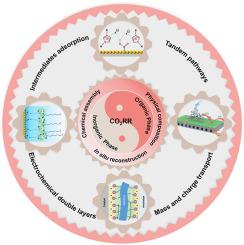Electrochemical CO2 reduction catalyzed by organic/inorganic hybrids
Abstract
Electroreduction of CO2 into value-added chemicals and fuels utilizing renewable electricity offers a sustainable way to meet the carbon-neutral goal and a viable solution for the storage of intermittent green energy sources. At the core of this technology is the development of electrocatalysts to accelerate the redox kinetics of CO2 reduction reactions (CO2RR) toward high targeted-product yield at minimal energy input. This perspective focuses on a unique category of CO2RR electrocatalysts embodying both inorganic and organic components to synergistically promote the reaction activity, selectivity and stability. First, we summarize recent progress on the design and fabrication of organic/inorganic hybrids CO2RR electrocatalysts, with special attention to the assembly protocols and structural configurations. We then carry out a comprehensive discussion on the mechanistic understanding of CO2RR processes tackled jointly by the inorganic and organic phases, with respect to the regulation of mass and charge transport, modification of double-layer configuration, tailoring of intermediates adsorption, and establishment of tandem pathways. At the end, we outline future challenges in the rational design of organic/inorganic hybrids for CO2RR and further extend the scope to the device level. We hope this work could incentivize more research interests to construct organic/inorganic hybrids for mobilizing electrocatalytic CO2RR towards industrialization.


 求助内容:
求助内容: 应助结果提醒方式:
应助结果提醒方式:


